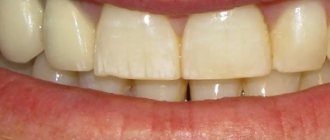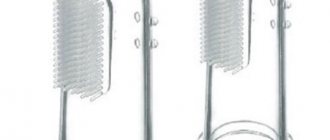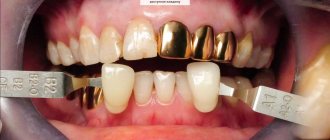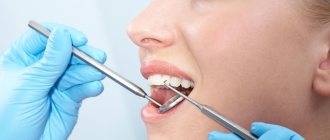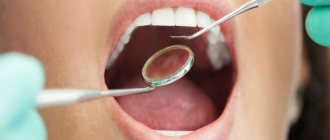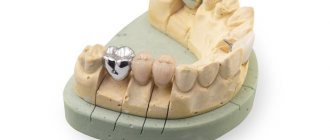Metal-ceramic crowns are the most popular method of dental prosthetics because they have a number of advantages: their appearance is as close as possible to natural, and they can last for many years without signs of wear.
Metal-ceramic prostheses are made in the form of bridges or crowns. Crowns made of this material perfectly replace molars, for which functionality is primarily important.
And although such prostheses are highly durable, they require certain care. Following some simple rules allows you to keep crowns in excellent condition and significantly increases their service life.
What types of dentures are there and what are they made of?
Today, the types of dentures, as well as the materials from which they are made, are varied. If the patient is missing one tooth and its root has not been preserved, then it would be best to install an implant and a dental crown on it. If several teeth are missing in the oral cavity, the situation will be saved by installing a bridge (possibly also on implants as the most reliable design). In the case of complete edentia, we will talk about restoring teeth using a complete denture, be it a fixed denture on implants or a complete removable denture.
We should not forget that the material from which dental crowns are made is no less diverse than the structures on which these crowns are fixed. In this case, the beauty and strength of the crown part of the tooth will depend on the material .
Considering the high degree of desired aesthetics, we can safely say that metal dental crowns are hopelessly outdated, just like crowns made of precious metals (white beautiful teeth have long replaced shiny gold teeth). The leading positions are occupied by zirconium dioxide crowns and all-ceramic dental crowns (metal-free ceramic crowns). But along with them, thanks to decent aesthetics and reasonable prices, metal-ceramic crowns remain quite in demand, which we will talk about in more detail.
Features of wearing removable dentures
Removable dentures have some features. When designing removable dentures, it is impossible to take into account several factors that can only appear while wearing the dentures. This is the degree of pressure of the prosthesis on the gum and the degree of fixation of the prosthesis. It happens that at first patients are concerned about pain when wearing dentures.
Correction of removable dentures
Correction of removable dentures - grinding of the structure in places of contact with the oral mucosa - is carried out the next day after installation of the denture. During the first two weeks of wearing the structure, several adjustments to the prosthesis may be required.
The correction procedure is carried out in the dental office by the attending dentist. Before visiting a doctor to have your denture adjusted, be sure to wear it and walk around with it for at least three to four hours. Also, do not carry out self-correction of a removable denture using improvised tools. At best, this will completely disrupt the fixation of the prosthesis, and at worst, it will lead to a breakdown, after which it is impossible to restore the structure - you will have to make a new one.
If the denture rubs the gum
Some patients, when wearing dentures for the first time, complain that the structure rubs their gums. This is the result of the oral cavity “getting used to” a foreign object. In order to get rid of unpleasant sensations, consult a doctor - he will correct the prosthesis. Don't tolerate discomfort. In the place where the prosthesis rubs, an inflammatory process can form, and healing due to constant friction is almost impossible. If you cannot get to the orthopedist who installed the prosthesis for you, you can turn to us for a service - at the clinic on Shchelkovskaya. An experienced specialist will see you and help you adjust the prosthesis so that nothing bothers you. Just call 8 (495) 033-00-63 or leave your details in the registration form on our website.
Fixation of the prosthesis
The anatomical features of the jaw structure in some people create obstacles to comfortable wearing of dentures. In such cases, you can use a special fixing gel, which is applied in a thin line to the prosthesis. This gel is completely invisible to humans and is absolutely safe. It is better to choose a gel in consultation with your doctor.
Broken prosthesis
During the use of prostheses, due to various factors, the prosthesis may break, as well as cracks and chips. In such cases, you must immediately consult a doctor to repair the structure. The repair period for a prosthesis is up to three days; making a new design (if the old one cannot be corrected) takes a week.
Metal-ceramic dentures
Metal-ceramic dentures are dental crowns consisting of a metal frame and a ceramic coating. This design looks quite natural and lasts a long time, so metal-ceramic crowns are installed both in place of one missing tooth and several teeth in the dentition (in this case we are talking about a bridge made of metal-ceramics). The metal-ceramic frame of the future crown is made from alloys of nickel and chromium, cobalt and chromium, a base of palladium and silver, gold or platinum. The latter components rarely fit into the pricing policy for metal-ceramic crowns, which stably maintains the demand for this type of dental crown, so the decision to install a metal-ceramic crown is still supported taking into account inexpensive manufacturing materials, which ensure the low cost of metal-ceramic dentures.
Stages of installing a metal-ceramic crown
Prosthetics are more the work of a dental technician than an orthodontist. The crown will be made in 7-10 days. However, before installation, it is necessary to prepare the patient, carry out appropriate treatment if necessary, and also prepare the tooth. Therefore, you will need to visit the clinic 4-5 times (it is possible to combine several stages in one visit). If problems are discovered, the number of visits to the doctor will increase.
The presence of a pain symptom during installation of a prosthesis depends on the tooth:
- on the pulpless one the pain is not felt. However, if you ask for additional anesthesia, they will give it;
- on “living” teeth, with the root preserved, there is an unpleasant sensation, pain is felt during grinding. Anesthesia solves the problem, but it is advisable to do a test to avoid an allergic reaction.
When installing dental crowns, when a temporary prosthesis is installed, the edge of the gum may be damaged and discomfort may be felt, but this is a normal process - no medications are required. If there is increased nervous excitability, the pain threshold is low - you can take sedatives and painkillers (be sure to discuss this issue with your dentist!).
Diagnostics before installing crowns is necessary
Diagnostics
Clinical assessment of the oral cavity and tooth damage is a mandatory step before installation. This is an examination, the manipulations are painless. Orthodontist:
- examines the tooth, checking the severity of the midline (equator), the degree of destruction;
- notes fillings, degree of tooth mobility;
- identifies defects in bite and dentition;
- checks the distribution of occlusal load;
- pays attention to periodontal disease.
An x-ray may also be needed if there is inflammation or a suspected tumor. If there is no inflammatory process (it must be eliminated before installation), the tooth is cleaned of plaque and caries is treated. They are filled, if necessary, removing the nerve and additionally filling the canals.
Tooth preparation
Preparing a tooth for a metal-ceramic crown means grinding off part of the tooth so that the crown placed on top is in line with the rest of the teeth and does not interfere. The walls are shortened and smoothed, the tooth shape becomes cylindrical.
If the tooth root is healthy, the nerve is not removed. They try to keep the tooth alive, then it will not “dry out” under the crown - the service life of the metal-ceramics will increase. The abutment tooth for a metal-ceramic crown is prepared much more than when preparing to install an all-ceramic crown. Focus on the rules:
- The color of the structure, close to the natural tooth, is obtained by distributing the thickness of the ceramic: center - 1.3-1.4 mm;
- cutting part - 1.5-1.6 mm.
Like any dental procedures in the mouth, preparation is not the most pleasant, but it does not cause severe pain. At the patient’s request, the doctor will always inject an anesthetic to make him feel comfortable. When the preparation is not gentle, a significant amount of enamel and dentin (about 2 mm of hard tissue) is ground off; full anesthesia is performed with a living (intact) pulp.
Taking an impression, installing a temporary prosthesis
The orthodontist needs an impression of the upper and lower jaws to correctly make the crown so that the prosthesis is not perceived as something foreign. On the model made in plaster according to the cast, the height of the product, the angle of inclination, and the evenness of the dentition will then be checked. Sometimes an impression is made of the antagonist teeth and only the jaw where the crown will be installed.
Impression of teeth for making crowns
When making such crowns, impressions are used consisting of 2 layers:
- indicative (basic);
- clarifying (correcting).
First, gum retraction is performed under anesthesia to move it away from the tooth. The most painless method is mechanical, when the gum tray is opened using a thread soaked in a retraction compound. The groove opens, exposing the space between the tooth and the soft tissue.
An inlay is placed on the tooth, since any crown can be installed on it. The first impression is made using impression material and a special tray with perforations. Then the retraction thread is removed, a second layer (corrective) is applied, and the impression tray is again placed on the dentition according to the dental impressions. While the crown is being made, the orthodontist will install a temporary composite, and the patient will wear it for 1-2 weeks.
Manufacturing of a metal-ceramic crown
Stages of manufacturing a metal-ceramic crown:
- Creating a Casting Mold
- Formation of a metal frame
- Application and fixation of dentin, enamel, transparent layers
- Retouching with dye does not imitate carious lesions, only the necessary natural darkening.
The frame is modeled using different methods. For example, the Adapt method. The metal base is obtained by pressing a stamp. A more “jewelry” method is wax modeling. To make a metal-ceramic crown, a mock-up is first prepared from wax that accurately depicts the contours of the finished crown. Then the wax is cut off (this creates a platform for the ceramics), and a fireproof mold is prepared for casting.
The frame of the metal-ceramic crown, which has cooled after casting, is carefully removed and cleaned of the remains of the molding material, dissolving them in an acid solution. The sprue channels (through which the melt was poured into the mold) are removed and sent for a 10-minute firing. The temperature in the oven is 950-1000°C. After cooling, the metal base is adjusted to the required dimensions on the supporting tooth and ground.
Features of manufacturing a metal frame depend on the type of material:
- Soft alloys with a gold content of more than 70%. To prevent the appearance of bubbles on the surface, the finished area for ceramics is treated with a cutter or carbide boron, cleaned with steam, a solvent (for example, carbon tetrachloride or chloroform).
- Alloys of gold-palladium, gold-palladium-silver, palladium-silver and palladium-copper. Their peculiarity: they can change the color of the finished crown. Silver can “color” ceramics yellowish; copper will give a greenish tint. The finished area for the ceramic mass is treated with corundum grinding heads, cleaned in a sandblaster, and small deposits and dust are removed with steam or an organic solvent. Palladium in the base of most alloys absorbs (absorbs) air; when fired, oxygen, nitrogen and hydrogen are released, forming bubbles on the surface. Therefore, the formation of the frame includes the stage of vacuum heat treatment (degassing), when the temperature is maintained at 1000°C. The surface darkens to black.
- Nickel-chromium alloys. Corundum heads are used in processing. The ground frame is then heated to form an oxide film on the surface. Next, the metal base is polished with aluminum oxide particles using a microsandblaster and cleaned with a solvent or steam cleaner.
An opaque mass is applied in thin layers to the prepared metal-ceramic crown frame, which forms the dentin layer. For a natural depth of color, as in a healthy tooth, the first layer is the contour of the crown, setting the shape by cutting off the excess.
Further production of the metal-ceramic crown and ceramic superstructure is divided into 2 volumetric stages:
- Application of dentin coating followed by modeling.
- Condensation, i.e. vibration (for uniform distribution), blotting off excess moisture with special napkins and drying under a stream of hot air.
Manufacturing of metal-ceramic crowns
“Finger-shaped” grooves, which are very clearly visible under the enamel of a real tooth in young people, are obtained by cutting off small sections from the workpiece and smoothing the cuts with a brush. To give the metal-ceramic crown the effect of opalescence (dispersion of light), a lighter enamel mass is applied in the next layer. The final layer is colorless; it is this layer that gives the crown transparency and depth comparable to natural tooth enamel. The technician can even draw cracks (relevant for older patients), darken some areas (intertubercular space and cervical area) so that the metal-ceramic crown in the dentition looks natural.
Fitting and fixation of a metal-ceramic crown
Before installing a metal-ceramic crown, the patient wears a temporary one. All this, together with the temporary cement, is cleaned and the stump is dried. To prevent saliva from getting onto the base, a retraction thread is used. First, simply put on the crown to check the tightness of the fit. Only then does the final fixation of the metal-ceramic crown take place.
Each orthodontist has its own quality control. Some use a strip of paper, others check the installation with dental floss (a piece of paper, thread is held tightly between the teeth). After installing the crown, it is advisable to refrain from eating for 2-3 hours.
When can metal ceramics be installed?
Metal-ceramic dental crowns will be an excellent alternative to other dentures in the case of the absence of one tooth in any part of the dentition, although, given the availability today of more aesthetic dentures, metal-ceramics are preferred to be installed in the chewing area of the upper or lower jaws. Dental crowns made of metal-ceramics are often used to restore several lost teeth in a row - this design is called a “metal-ceramic bridge.” Typically, a metal-ceramic bridge replaces up to four missing teeth.
How to care for metal-ceramic dentures?
There is no need to talk about the fact that the basis of oral hygiene is brushing your teeth twice a day. The presence of metal-ceramic dentures in the oral cavity makes this rule unshakable. In addition, it is necessary to clean metal-ceramic dentures in a strictly specified direction - upward from the base to the top of the tooth, removing plaque and accumulated food particles from the spaces not only between the teeth, but also between the teeth and gums. More thorough care, of course, is facilitated by the use of an irrigator, which helps literally wash away food debris. It is also recommended to rinse the mouth with special disinfecting and anti-inflammatory solutions, use dental floss and other tools for cleaning dentures. If we are talking about caring for removable metal-ceramic dentures, in this case it is mandatory to rinse the denture under running water to avoid the accumulation of remaining food particles after eating and, as a result, bad breath. Thus, basic rules of oral care at home can significantly extend the service life of unpretentious metal-ceramic dentures. If you need more serious help, you can always contact a dental hygienist, who will definitely adjust the action plan.
When to see a doctor
It is necessary to visit a doctor for preventive purposes every six months. This rule applies not only to those who have crowns, but also to all other patients. If there are restorations with crowns in the row. You should have your teeth professionally cleaned by a hygienist every year. This will keep the structures clean, extend their service life and avoid the appearance of an unpleasant odor. During a preventive examination, a specialist will be able to identify disorders that have not yet made themselves known to the patient. An unscheduled visit is necessary in the following cases:
- The crown became movable.
- An unpleasant odor appeared. There is redness of the gums.
- It is painful to bite into a restored tooth.
- Discomfort or any unpleasant sensations appeared.
A timely visit will allow you to promptly identify and eliminate the cause of discomfort, avoiding complications.
Author:
Mayorov Andrey Mikhailovich
Specialization:
orthopedic dentistry, dental prosthetics, implant installation

